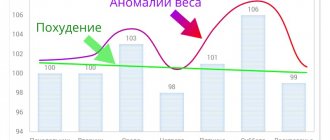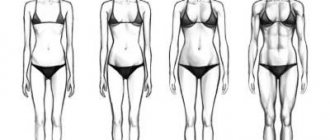January 8, 2021
- How to understand if you are overweight: calculate your body mass index
- Eat a balanced diet
- Stay hydrated
- Play sports
- Get enough sleep and smile
The goal determines the result. Do you want to lose weight? Then you should know how to correctly calculate excess weight and what figure to strive for.
In such a responsible matter, you should not look up to friends, fashion bloggers, or rely only on personal feelings. How to find out how much excess weight you have? Calculate BMI - body mass index (BMI, Body Mass Index) by calculating weight by height online.
Determining your body mass index will help you understand whether your current weight is normal, underweight or overweight. This is a springboard from which everyone who cares about their health and figure should start. BMI is often used to calculate drug doses and determine the risk of developing diseases associated with obesity or wasting.
How to understand if you are overweight: calculate your body mass index
Body mass index is calculated using the formula: BMI = weight in kg / (height in m)2
For automatic calculation, use our body mass index calculator for women and men: just enter your height and weight into the excess weight calculator to calculate your body mass index for free.
Body Mass Index (BMI) Calculator
Compare the resulting number with the body mass index values in the table:
| Body mass index | Correspondence between a person's mass and his height |
| less than 16 | Severe underweight |
| 16–18,5 | Underweight |
| 18,5–25 | Norm |
| 25–30 | Excess body weight (pre-obesity) |
| 30–35 | Obesity of the first degree |
| 35–40 | Obesity of the second degree |
| 40 or more | Obesity of the third degree |
Notes: 1. You will receive an average value: ideally, you need to calculate weight for weight loss taking into account your body type, age and height. 2. Professional athletes with well-developed muscles will have a higher BMI, because muscle is heavier than fat. 3. You should not calculate BMI during pregnancy. 4. This BMI calculation is not suitable for children under 19 years of age: according to WHO, BMI for this age group is calculated differently [].
If you are obese or underweight, it is important to seek advice from a qualified specialist: any deviations from the norm can cause diseases and disruptions in the body.
To achieve and maintain a healthy weight, you need to work on:
- food;
- water balance;
- lifestyle;
- mood.
This is exactly what Amway's comprehensive Body Detox program teaches.
Formulas for calculating ideal weight
For ease of calculation, as well as to obtain the most accurate results, we have selected the most popular formulas used all over the world.
The parameters used in the formulas can be viewed in the table:
| Formula | Height | Floor | Age | Wrist circumference | Bust volume |
| Broca's index | ✓ | ✓ | — | — | — |
| Broca-Brugsch index | ✓ | — | — | — | — |
| Mohamed's formula | ✓ | — | — | — | — |
| Broca's index taking into account body composition | ✓ | — | — | ✓ | — |
| Bornhardt index | ✓ | — | — | — | ✓ |
| Monneroth-Dumain formula | ✓ | — | — | ✓ | — |
| Kref's formula | ✓ | — | ✓ | ✓ | — |
| Formula "Metropolitan Life" | ✓ | — | ✓ | — | — |
| Lorentz formula | ✓ | ✓ | — | — | — |
| Potton exponent | ✓ | ✓ | — | — | — |
| Devin formula | ✓ | ✓ | — | — | — |
| Robinson's formula | ✓ | ✓ | — | — | — |
| Miller's formula | ✓ | ✓ | — | — | — |
| Formula Humvee | ✓ | ✓ | — | — | — |
| Nagler's formula | ✓ | ✓ | — | — | — |
| Cooper's formula | ✓ | ✓ | — | — | — |
| WHO recommendations | ✓ | ✓ | — | — | — |
Broca's index
The formula for calculating the ideal weight of the French anthropologist Paul Broca, developed in 1871. Broca's index
Broca-Brugsch index
The Broca-Brugsch index is a refinement of the Broca formula and allows you to determine the ideal weight for people with a height of less than 155 cm and above 175 cm. Broca-Brugsch index
Mohamed's formula
Mohamed's formula was developed in 2010 and is one of the most recent for calculating a person's ideal weight. Mohamed's formula
Broca's index taking into account body composition
Broca's index with the addition of one more variable - wrist circumference. Broca's index taking into account body composition
Bornhardt index
The Bornhardt index was developed back in 1886, despite this it has a fairly high accuracy due to the addition of such a variable as breast volume. Bornhardt index
Monneroth-Dumain formula
Monneroth-Dumain formula for calculating a person’s normal weight taking into account their physique. Monneroth-Dumain formula
Kref's formula
The Kreff formula for calculating weight is the most improved version of the Broca index, taking into account a person’s physique and age. Kref's formula
Formula "Metropolitan Life"
Formula for calculating a person’s normal weight from the insurance company Formula “Metropolitan Life”
Lorentz formula
Lorenz formula for calculating ideal weight taking into account a person’s height and gender. Lorentz formula
Potton exponent
The Potton Score uses only a person's height and gender when calculating weight. Potton exponent
Devin formula
Devin's formula allows you to calculate a person's weight according to his height and gender. Devin formula
Robinson's formula
Robinson's formula is an improved version of Devin's formula. Robinson's formula
Miller's formula
Miller improved Devin's method, based on mathematical calculations, and came up with his own formula for calculating the ideal weight for men and women based on their height. Miller's formula
Formula Humvee
Formula for calculating the ideal weight of a Humvee, developed in 1964. Formula Humvee
Nagler's formula
Nagler's formula calculates ideal weight based on a person's gender and height. Nagler's formula
Cooper's formula
The formula for calculating ideal weight from the author of the book “Super Diet Without Fat” Robert Cooper. Cooper's formula
Eat a balanced diet
The body must receive the required amount of proteins, fats and complex carbohydrates (BCC). Eat fish and seafood, meat, eggs and dairy products, nuts, cereals and legumes, vegetable oils, green vegetables.
But the body needs proteins, fats and carbohydrates in different quantities. In addition, proteins are divided into complete and incomplete, fats into saturated and unsaturated. Their proportions in the daily diet also differ...
It's easy to get confused about this, especially if you're not very knowledgeable about healthy eating. What foods to choose, how to correctly calculate the calorie content of dishes, what to cook so as not to sit on one salad all day? There are really a lot of questions.
To answer them, Amway specialists have developed a comprehensive Body Detox program. In just 3 weeks you can easily change your eating habits and learn to eat tasty and balanced. Breakfast, lunch, dinner and two healthy snacks: just select several dishes from the Body Detox menu and create your daily diet. There is no need to invent new combinations or constantly eat the same thing, there is no need to manually count calories. All recipes are described step by step, for each dish its calorie content and BJU are indicated.
NUTRILITE™ Appetite control with glucomannan helps to cope with the constant feeling of hunger and the desire to eat more than necessary. There is no need to test your willpower: just mix one portion of the dietary supplement with water or juice and drink shortly before meals. When in contact with water, glucomannan increases from 50 to 200 times, it envelops the stomach, partially fills it and creates a feeling of fullness.
You can even treat yourself to something sweet! But it’s better - in the first half of the day and not too often. Buns and chocolate bars should be replaced with fruits, nuts or a delicious smoothie with a mixture of dietary fiber with NUTRILITE™ inulin.
How to calculate BMI
You can calculate body mass index in various ways, independently or using free online services. The most famous formulas:
- according to Brock;
- according to Quetelet;
- according to Devin;
- according to Kreff;
- according to Lorenz.
BMI formulas help determine the amount of extra pounds.
BMI according to Brock
Paul Brocque was a French anthropologist and surgeon. He developed a formula for ideal weight, taking into account the natural changes in a person’s body weight over the course of his life. Brock's predecessors did not include in the calculation such data as:
- age category;
- height;
- constitution.
Paul Brokk argued that weight changes with age are natural, and weight that is considered excessive in youth will be acceptable for a more mature person. He proposed the following BMI formula:
normal body weight = height (cm) – 110.
The formula is quite simple, but has a few caveats. For example, people over the age of 40 can subtract not 110, but 100 units.
Over time, Brocca's formula was supplemented by Brugsch and began to look like this:
- normal body weight = height (cm) - 100 (valid for people whose height is less than 165 cm);
- normal body weight = height (cm) – 105 (valid for height 165-175 cm);
- normal body weight = height (cm) – 110 (valid for height over 175 cm).
In addition, Brokk took into account the general constitution of a person and identified 3 types: asthenics with a thin physique, tall stature and narrow bones, hypersthenics with wide bones and developed muscles, and normosthenics with an average physique. The Brocca BMI calculator is taken in its pure form only for normosthenics. Asthenics should subtract 10% from the result obtained, and hypersthenics should multiply the total by 1.1.
Quetelet's formula
Belgian sociologist and statistician Adolphe Quetelet developed the mass index in 1869 to determine the degree of obesity or malnutrition. Quetelet was driven by the desire to find a simple and accessible way to assess the possible risks of the occurrence and development of diseases that are associated with excess weight.
According to the very common Quetelet formula, BMI is equal to the ratio of weight in kilograms to height in meters raised to the second power. Depending on the value obtained, you can see whether the mass is insufficient, acceptable or excessive.
Quetelet did not forget to include age in the calculation, and for each category by year the value must be looked at separately.
At the age of 19-24, people with normal body weight have an index from 19 to 24, then until the age of 34, an acceptable BMI is 20-25. At the age of 35-44 years, the desired BMI can vary from 21 to 26 units. After 45 years, normal BMI is included in the interval 21-27, and after 55 years - 21-28. For people over 65 years of age, an acceptable rate can be from 21 to 29 units.
Lorentz formula
The formula for finding the ideal weight according to Lorentz is quite simple, even simplified. He proposes to find the difference from 2 values: the first is height in centimeters minus 100, and the second is height in centimeters divided by 2. Even simpler, the optimal value that weights should show according to Lorenz’s point of view can be found by dividing height by centimeters by 2 and subtract 25 units from the result.
There are 2 significant limitations for the Lorenz formula: it is only suitable for women whose height is exclusively less than 175 cm. The disadvantage of these calculations is that indicators such as age and body type are not taken into account.
Devin formula
Devin proposed his method for determining ideal weight in 1974. Initially, his goal was to determine the dose of medications, since Demin was a doctor by type of his professional activity. However, his formula quickly gained popularity and is still used to determine BMI.
Calculations for women and men according to Devin are not the same and have a rather complex structure compared to other formulas. Perhaps, due to taking into account many coefficients, his formula gives a more accurate result. It looks like this:
- BMI=50+2.3*(0.394*height-60) – used for men;
- BMI=45.5+2.3*(0.394*height-60) – used for women.
Kref's formula
Kreff improved Brocca's formula by adding age and body composition coefficients. To calculate your BMI, you need to measure not only your height and weight, but also your wrist circumference. To calculate the optimal weight, you need to add 2 values: height in centimeters minus 100 and the number of full years divided by 10. The resulting result should be multiplied by 0.9, and then multiplied by a coefficient depending on the circumference of the wrist:
- 0.9 if wrist circumference is less than 15 cm;
- 1, if the wrist circumference is 15-17 cm;
- 1.1 if the wrist circumference is more than 17 cm.
Causes of obesity
Excess weight accumulates due to certain diseases of the endocrine or digestive system and is a consequence of metabolic disorders. However, most often extra pounds are formed due to eating disorders. A person eats not at the request of the body and not according to a well-designed regimen, but simply for pleasure. More calories are consumed than needed for life. Unused calories are converted into reserves in the form of fat.
Experts call the type of obesity that occurs as a result of unhealthy eating behavior nutritional or exogenous constitutional. The higher the degree of obesity, the more difficult it is to fight it. Thus, the third degree is a condition in which surgical assistance is often used with a long, difficult rehabilitation process. Therefore, the first signs of obesity are a signal that you need to seriously take care of yourself and bring your body weight back to normal.
There are certain pathologies in which obesity is especially dangerous. For example, metabolic disorders cause visceral obesity, when fat tissue accumulates around internal organs, making it difficult for them to function. This condition occurs in diabetic patients with insulin resistance.
Pregnancy is often the cause of pre-obesity and obesity in women. A whole set of factors plays a role here - hormonal changes, the body’s increased need for nutrients, a decrease in the psychological barrier to overeating, the inability to play sports, etc. In any case, after the body has been restored, you should consult with a specialist and normalize your weight.
When the functions of the hypothalamus are impaired, hypothalamic obesity occurs, which is treated with medication. There is a pituitary problem that is associated with a violation of brain secretion and also requires treatment with drugs. Pituitary weight gain is a problem for young guys, but it can occur in people of different ages of both sexes after traumatic brain injury, as well as in women during the postpartum period.
The psychosomatics of excess weight also matters. Psychological mechanisms of replacement and compensation force a person to overeat, gaining more and more extra pounds, ignoring the deterioration of well-being and his own appearance. All variants of excess obesity, except those provoked by physical illnesses, are based on psychosomatics.
What are the dangers of being overweight?
The problem affects various aspects of human life. From an aesthetic point of view, the situation is ambiguous: some people like fullness, others do not. The only fact remains is the negative impact of excess body weight on health. It is no secret that obesity increases the likelihood of developing the following diseases:
- diabetes mellitus;
- arterial hypertension;
- atherosclerosis;
- heart attack;
- stroke;
- pancreatitis, etc.
These diseases reduce the length and quality of life and can also cause death. If you have excess body weight, it must be reduced without waiting until the situation becomes critical.









